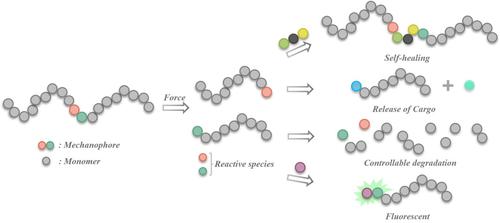当前位置:
X-MOL 学术
›
Chin. J. Chem.
›
论文详情
Our official English website, www.x-mol.net, welcomes your feedback! (Note: you will need to create a separate account there.)
Polymer Mechanochemistry on Reactive Species Generated from Mechanochemical Reactions†
Chinese Journal of Chemistry ( IF 5.4 ) Pub Date : 2024-03-27 , DOI: 10.1002/cjoc.202300660 Xiaolong Chen 1 , Hang Shen 1 , Zhengbiao Zhang 1
Chinese Journal of Chemistry ( IF 5.4 ) Pub Date : 2024-03-27 , DOI: 10.1002/cjoc.202300660 Xiaolong Chen 1 , Hang Shen 1 , Zhengbiao Zhang 1
Affiliation

|
Comprehensive SummaryPolymer mechanochemistry on reactive species has attracted more and more attentions over the past 20 years, as the mechanochemical generation of reactive species has a great potential in developing different polymeric materials for various purposes, such as stress detection, self‐healing, self‐strengthening, controllable degradation and release of small molecules. In this review, we first discuss the recent progress on polymer mechanochemistry of the reactive species that are generated from the mechanochemical reactions of mechanophores. Five types of reactive species, including radical, zwitterion, ionic, carbene and neutral intermediates, and their applications were reviewed in detail. Since mechanochemical reactions are sensitive to the mechanophore structure and polymer framework, we then discuss how mechanophore isomerism, polymer structure, polymer attachment point, and polymer architecture influence the mechanophore activation. At last, we provide our perspectives on the polymer mechanochemistry of reactive species.N ‐heterocyclic carbene) adduct in 2020. During that time, the Choi group explored the influence of polymer architecture on the mechanophore activation, and Robb's group utilized a furan‐maleimide adduct to achieve the release of different small molecules. In 2020, Göstl and Herrmann employed the scission of the disulfide within polymers to release drugs and reporting molecules by ultrasound, and the Chen group also investigated the mechanochemistry of diselenides which afforded selenium radicals. In 2021, Boydston's group realized the “flex‐activation” of NHC‐carbodiimide to release NHC small molecules. Recently, the Chen group achieved multistate mechanochromism by combining two Rh structures together through a conjugated connector. In addition, Robb designed a furan‐maleimide adduct to mechanically give a donor–acceptor Stenhouse adduct that reacted with different amines to display various colors. This review has focused on the chemistry of reactive species that are generated from mechanochemical reactions.
中文翻译:

机械化学反应产生的反应物质的聚合物机械化学†
综合总结在过去的20年里,活性物种的聚合物机械化学引起了越来越多的关注,因为活性物种的机械化学生成在开发用于各种目的的不同聚合物材料方面具有巨大的潜力,例如应力检测、自修复、自增强等。 ,可控降解和释放小分子。在这篇综述中,我们首先讨论了由机械力团的机械化学反应产生的活性物质的聚合物机械化学的最新进展。详细综述了自由基、两性离子、离子、卡宾和中性中间体等五种活性物种及其应用。由于力化学反应对力团结构和聚合物框架敏感,因此我们随后讨论力团异构、聚合物结构、聚合物附着点和聚合物结构如何影响力团活化。最后,我们提出了对活性物质的聚合物机械化学的看法。关键科学家 20 世纪 30 年代,施陶丁格 (Staudinger) 的一项开创性工作表明,聚苯乙烯的分子量在塑炼后会降低。然而,高分子机械化学主要关注机械力的破坏作用,直到2005年Moore报道了偶氮机械载体在超声处理下被选择性裂解。随后,他的团队还发现机械力改变了苯并环丁烯的反应途径,使螺吡喃呈现紫色。压力下的颜色。 2009年,Sijbesma揭示金属-NHC可以作为潜在催化剂来催化酯交换和聚合反应。随后,Craig课题组于2011年披露了全氟环丁烷的特殊机械反应性,并于2012年研究了聚合物主链对环氧化物反应性的影响。随后,他们还报道了杠杆臂效应增强了gDBC或gDCC机械化学性能。自2015年以来,大冢团队开发了一系列机械载体,它们在机械力作用下产生各种碳自由基并呈现不同的颜色。 De Bo随后于2017年研究了区域化学和立体化学对呋喃-马来酰亚胺加合物反应性的影响,并研究了四氟苯-NHC机械活化的不同机制(氮 ‐杂环卡宾)加合物于2020年问世。在此期间,Choi小组探索了聚合物结构对力团活化的影响,而Robb小组则利用呋喃-马来酰亚胺加合物来实现不同小分子的释放。 2020年,Göstl和Herrmann利用聚合物内二硫键的断裂来通过超声波释放药物和报告分子,Chen小组还研究了提供硒自由基的二硒化物的机械化学。 2021年,Boydston团队实现了NHC-碳二亚胺的“弯曲激活”以释放NHC小分子。最近,陈团队通过共轭连接器将两个 Rh 结构组合在一起,实现了多态机械变色。此外,Robb 设计了一种呋喃-马来酰亚胺加合物,以机械方式产生供体-受体 Stenhouse 加合物,该加合物与不同的胺反应,显示不同的颜色。本综述重点关注机械化学反应产生的活性物质的化学。
更新日期:2024-03-27
中文翻译:

机械化学反应产生的反应物质的聚合物机械化学†
综合总结在过去的20年里,活性物种的聚合物机械化学引起了越来越多的关注,因为活性物种的机械化学生成在开发用于各种目的的不同聚合物材料方面具有巨大的潜力,例如应力检测、自修复、自增强等。 ,可控降解和释放小分子。在这篇综述中,我们首先讨论了由机械力团的机械化学反应产生的活性物质的聚合物机械化学的最新进展。详细综述了自由基、两性离子、离子、卡宾和中性中间体等五种活性物种及其应用。由于力化学反应对力团结构和聚合物框架敏感,因此我们随后讨论力团异构、聚合物结构、聚合物附着点和聚合物结构如何影响力团活化。最后,我们提出了对活性物质的聚合物机械化学的看法。



























 京公网安备 11010802027423号
京公网安备 11010802027423号